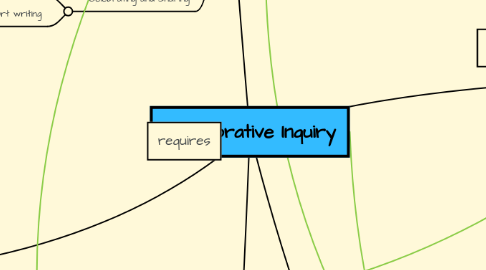
1. Design
1.1. Self Regulated Learnig
1.1.1. Self-awareness, self-motivation and academic skills to implement knowledge in design
1.2. Framing the problem
1.2.1. A shared vision
1.2.2. Inquiry question
1.2.3. Theory of actions
1.3. Evidence collections
1.3.1. Type of date
1.3.1.1. Students learning
1.3.1.2. Demographic
1.3.1.3. Perceptional
1.3.1.4. School process
1.3.2. Sources of evidence
1.3.3. Collection methods
1.3.4. Collection time line
1.4. Evidence analysis
1.4.1. Organizing data
1.4.2. Read data
1.4.3. Describe data
1.4.4. Classifying data
1.4.5. Interpreting data
1.5. Celebrating and Sharing
1.5.1. Preparation
1.5.2. Report writing
2. Collaboration
2.1. Participants
2.1.1. Classroom teacher
2.1.2. Parents
2.1.3. School personnel
2.1.4. students
2.2. Awareness
2.2.1. Understanding of the activities of others, establishes purpose
2.3. Motivation
2.3.1. The driving force of collaboration
2.4. Guidelines
2.5. Divide responsibilities
2.6. Reflection
2.6.1. Serious thought and consideration which will help to move you forward
2.7. Egagement
2.7.1. Emotional commitment to the team
2.8. Trust
2.8.1. Must have embraces transparency and accountability
2.9. Teacher team formation
2.9.1. Regular meetings
2.9.2. Shared goals
2.9.3. Effective coordination
2.10. Engage external resources
2.10.1. Collaboration tools (technology)
2.10.1.1. Chormoe
2.10.1.2. Skype
2.10.1.3. Google accounts
2.10.1.4. Dropbox
2.10.1.5. Facebook
2.10.1.6. You Tube
3. Burning Questions
3.1. How can schools’ leadership ensure effective collaboration between staff?
3.2. Does collaborative inquiry look different if its adults or children doing?
3.3. How can teachers design an effective CI to meet students’ needs when coming from different backgrounds?
4. leads to
5. will answer
6. will answer
7. requires
8. Benefits from
9. Problem Solving
9.1. Well Structured Problems
9.1.1. Present all elements of the problems to students
9.1.2. Apply limited number of well-structured rules and principle
9.1.3. Clear solutions
9.2. Ill Structured Problems
9.2.1. How do we tackle these in the classroom with the same constraints day/subject period or year?
9.2.2. Learners to make judgments and express personal opinions or beliefs about the problem
9.2.3. Multiple solutions, solution paths or no solutions
9.2.4. Problem elements unknown
9.2.5. Multiple criteria for evaluating solutions
10. Inquiry
10.1. Where to determine
10.1.1. Students' results
10.1.2. Professional practices
10.2. How to identify
10.2.1. data informed approach
10.2.2. manageable inquiry
10.2.3. Teacher team collaboration
